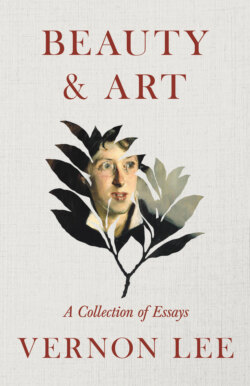Читать книгу Beauty & Art - A Collection of Essays - Vernon Lee - Страница 9
На сайте Литреса книга снята с продажи.
III
ОглавлениеBefore beginning to expound the virtues of Beauty, let me, however, insist that these all depend upon the simple and mysterious fact that—well, that the Beautiful is the Beautiful. In our discussion of what the Bay Laurel symbolises, let us keep clear in our memory the lovely shape of the sacred tree, and the noble places in which we have seen it.
There are bay twigs, gathered together in bronze sheaves, in the great garland surrounding Ghiberti's Gates of Paradise. There are two interlaced branches of bay, crisp-edged and slender, carved in fine low relief inside the marble chariot in the Vatican. There is a fan-shaped growth of Apollo's Laurel behind that Venetian portrait of a poet, which was formerly called Ariosto by Titian. And, most suggestive of all, there are the Mycenaean bay leaves of beaten gold, so incredibly thin one might imagine them to be the withered crown of a nameless singer in a forgotten tongue, grown brittle through three thousand years and more.
Each of such presentments, embodying with loving skill some feature of the plant, enhances by association the charm of its reality, accompanying the delight of real bay-trees and bay leaves with inextricable harmonics, vague recollections of the delight of bronze, of delicately cut marble, of marvellously beaten gold, of deep Venetian crimson and black and auburn.
But best of all, most satisfying and significant, is the remembrance of the bay-trees themselves. They greatly affect the troughs of watercourses, among whose rocks and embanked masonry they love to strike their roots. In such a stream trough, on a spur of the Hill of Fiesole, grow the most beautiful poet's laurels I can think of. The place is one of those hollowings out of a hillside which, revealing how high they lie only by the sky-lines of distant hills, always feel so pleasantly remote. And the peace and austerity of this little valley are heightened by the dove-cot of a farm invisible in the olive-yards, and looking like a hermitage's belfry. The olives are scant and wan in the fields all round, with here and there the blossom of an almond; the oak woods, of faint wintry copper-rose, encroach above; and in the grassy space lying open to the sky, the mountain brook is dyked into a weir, whence the crystalline white water leaps into a chain of shady pools. And there, on the brink of that weir, and all along that stream's shallow upper course among grass and brakes of reeds, are the bay-trees I speak of: groups of three or four at intervals, each a sheaf of smooth tapering boles, tufted high up with evergreen leaves, sparse bunches whose outermost leaves are sharply printed like lance-heads against the sky. Most modest little trees, with their scant berries and rare pale buds; not trees at all, I fancy some people saying. Yet of more consequence, somehow, in their calm disregard of wind, their cheerful, resolute soaring, than any other trees for miles; masters of that little valley, of its rocks, pools, and overhanging foliage; sovereign brothers and rustic demi-gods for whom the violets scent the air among the withered grass in March, and, in May, the nightingales sing through the quivering star night.
Of all southern trees, most simple and aspiring; and certainly most perfect among evergreens, with their straight, faintly carmined shoots, their pliable strong leaves so subtly rippled at the edge, and their clean, dry fragrance; delicate, austere, alert, serene; such are the bay-trees of Apollo.
